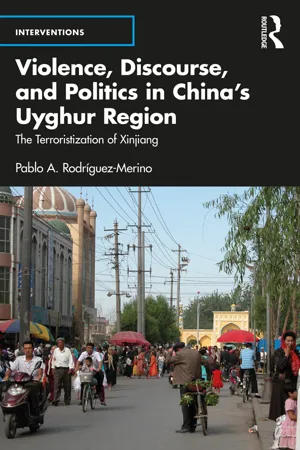
Violence, Discourse, and Politics in China's Uyghur Region
The Terroristization of Xinjiang
- 246 pages
- English
- ePUB (mobile friendly)
- Available on iOS & Android
Violence, Discourse, and Politics in China's Uyghur Region
The Terroristization of Xinjiang
About This Book
This book investigates how Uyghur-related violent conflict and Uyghur ethnic minority identity, religion, and the Xinjiang region, more broadly, became constituted as a 'terrorism' problem for the Chinese state.
Building on securitization theory, Critical Terrorism Studies (CTS), and the scholarly definitional debate on terrorism, it develops the concept of terroristization as a critical analytical framework for the study of historical processes of threat construction. Investigating the violent events reported in Xinjiang since the early 1980s, the evolving discursive patterns used by the Chinese state to make sense of violent incidents, and the crackdown policies that the official terrorism discourse has legitimized, the book demonstrates how the securitization, and later terroristization, of Xinjiang and the Uyghurs, is the result of a discursive and political choice of the Chinese state. The author reveals the contingent and unstable nature of such construction, and how it problematizes the inevitability of the rationale behind China's 'war on terror', that has prescribed a brutal crackdown as the most viable approach to governing the tensions that have historically characterized China's rule over the Turkic Muslim ethnic minorities in Xinjiang.
This book will be of interest to scholars and students of the politics of contemporary China, security and ethnic minority issues, International Relations and Security, as well as those adopting discursive approaches to the study of security, notably those within the critical security and terrorism studies fields.
Frequently asked questions
Information
Table of contents
- Cover
- Half Title
- Series Page
- Title Page
- Copyright Page
- Dedication
- Table of Contents
- List of Figures
- List of Tables
- Acknowledgements
- List of Abbreviations and Acronyms
- Note on Transliteration
- Introduction
- 1 From Securitization to ‘Terroristization’
- 2 Securitizing Xinjiang: The Years of ‘Counterrevolution’ (1978–1990)
- 3 The Proto-Terroristization of Xinjiang: ‘Striking Hard’ against the ‘Three Forces’ (1991–2001)
- 4 The Terroristization of Xinjiang (2001–2020): Waging a People’s War on Terror
- Conclusion
- Appendix: List of Violent Events
- Bibliography
- Index